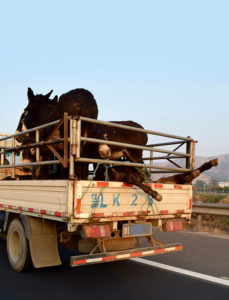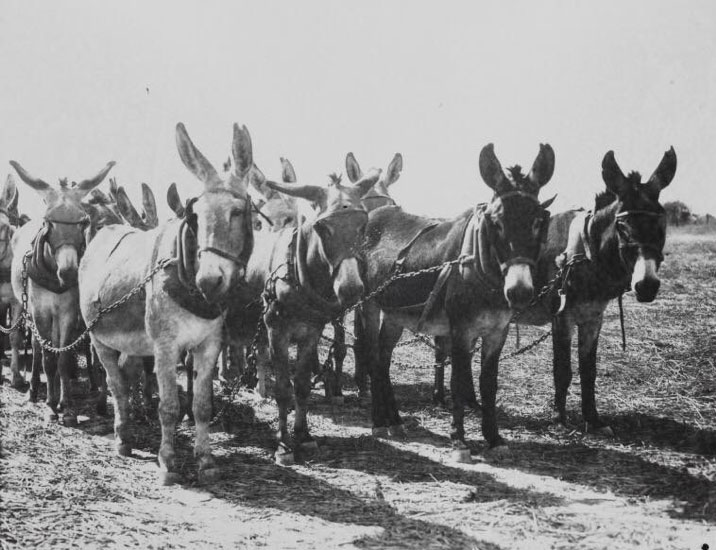FOR ALMOST TWO millennia, donkey hide glue (colla corii asini) has been part of the Chinese apothecary. Ejiao 阿膠, or ‘E-glue’ as this medicine is referred to in Chinese, consists of gelatin that is extracted from donkey hides by boiling them in water. According to traditional Chinese medicine, ejiao strengthens blood, stops bleeding, and improves the quality of vital fluids. It can be used to restore the vigour of depleted patients, or taken as a life-enhancing tonic to strengthen vitality and promote health. Recent biomedical clinical trials confirm the hematopoietic (blood cell producing) effect of donkey hide gelatin.
Historical records insist that only boiling the skins in water drawn from the ‘E Well’ 阿井 in Shandong province produces ejiao, and that only skins from the black Wu donkey 乌驴 would produce top-quality medicinal glue. The precinct of the E Well was protected by imperial armies and E-glue was sent annually to the imperial court. Thus ejiao remained an expensive regional delicacy that only the wealthy could afford. Genuine ejiao was hard to get hold of, and fakes were abundant. This problem was exacerbated in the 1990s, when entrepreneurs started to mix ejiao with dried fruits, nuts, and sesame seeds, marketing it as a beauty and wellness booster with anti-ageing and health-promoting properties. It is now a coveted luxury product for ostentatious consumption and gift giving, comparable to ginseng or expensive tea.
The success of this repackaging campaign in China’s age of prosperity has led to exponential growth in the consumption of ejiao, with production soaring to meet demand. As a result, China’s donkey population has plummeted, falling from 9.4 million to less than six million in 2017 (with unverified reports saying the number is closer to three million). With industrialisation, fewer donkeys are being raised as farm animals in the first place, and their sensitivity makes them ill-suited for mass breeding. So China’s ejiao industry depends heavily on imported hides. Currently 1.8 million donkey hides are traded globally every year, with demand estimated at between four and ten million. With only around forty-four million donkeys worldwide, Chinese demand could lead to total extinction within a short time.
The demand for donkey hides also creates severe problems for the world’s poorest communities, which are still heavily dependent on donkeys as work animals. The spike in the market price of donkeys has led to an increase in theft and poaching in countries such as Tanzania and South Africa, with heartbreaking reports of farmers or even whole villages waking up to find the skinned remains of their donkeys in a nearby field, after a poacher’s strike in the night.
The increase in the donkeys’ market price makes it impossible for many families to replace them. This leads to financial ruin: their children can no longer go to school, and they can no longer easily fetch drinking water or transport firewood. In an attempt to protect local economies, a number of countries including Uganda, Tanzania, Botswana, Niger, Burkina Faso, Mali, Senegal, and Nigeria have already banned donkey exports to China. Others, such as Kenya, attracted by the high returns of the donkey trade, have allowed Chinese investment in state-sanctioned donkey slaughterhouses. The profits of this questionable trade benefit few, and devastate many. Donkeys that are traded for their hides are also often poorly looked after — or even starved to death — during gruelling long-distance live transports, or while waiting for slaughter: the market value of a hide is not affected by the poor health of the donkey that used to live inside it.
Even Chinese medicine is a victim, rather than a culprit of this excessive ejiao consumption. As the price of ejiao goes up, fewer and fewer patients can afford or obtain genuine ejiao when they need it. Instead, they are being fobbed off with wellness candies that have no medical efficacy.
In their quest to overcome the shortage of donkey skins, China’s ejiao investors have set their eyes on Australia. In 2004, Australia had an estimated population of five million feral donkeys concentrated in the arid regions of the country’s centre. They are the descendants of the finest donkey breeds of the world, imported by early settlers from Spain, Chile, Mexico, and India. The earliest donkeys arrived in Australia in 1794, but it was not until the 1890s that they began to play a key role in opening up the outback. Essentially a desert animal, donkeys are more resistant to drought, heat, and toxic plants than horses. ‘Teamster donkeys’, harnessed four to five abreast in teams of up to forty animals, transported wood, food, mining supplies, and wool across the country. Their hardiness, docility, and ability to haul heavy loads made them indispensable for developing the colonies.
In the 1930s, mechanised transport made the teamster obsolete. Teamsters, not wanting to kill their former work animals, simply released them into the wild. The donkeys thrived and multiplied to such an extent that they were soon considered to pose a problem for the arid soil, and were declared a pest in the Northern Territory as early as 1949.

Donkeys are often poorly looked after or die during live transport
Source: George Knowles Hong Kong georgeeknowles@yahoo.com
The view that donkeys are a pest is shared by the agribusiness sector. In March 2017, the then minister for agriculture Barnaby Joyce announced his intention to make the export of donkey skin part of a bilateral trade deal: ‘We are going to make sure that if you want to eat edible donkey skins then you are going to be eating our edible donkey skins’. Several months later, Northern Territory Minister for Primary Industries and Resources Ken Vowles visited China’s largest ejiao processing factory, Dong E Ejiao, in Shandong.
Other Australians feel strong attachment to the ‘beautiful Australian bush donkey’ that has become an integral part of the Australian landscape. Fortunately, live exports are off the table for the time being. But a multi-species abattoir is being built in Charleville, Queensland and mustering of feral donkeys has started in the Anangu Pitjantjatjara Yankunytjatjara Territories in Southern Australia. Despite the pleas of animal rights activists to the Australian Government not to feed into a globally destructive trade, Australia has effectively already become an exporter of donkey skins.
Granted, the media images of donkey abbattoirs are gruesome, but the same goes for slaughterhouses for cattle or pigs. Since the number of Australian donkeys is already controlled by aerial culling, one might argue that this way at least their skin goes to use. Yet the scale of the trade, which threatens global extinction of a whole species, is devastating rural communities worldwide, and lacks any form of legislation and control.
This raises legitimate questions about ethics and sustainability for any country involved in the skin trade, including Australia. Historically, ejiao was a regional delicacy, a ‘medicine for emperors’; today it is a wellness candy, mass-produced for conspicuous consumption by the affluent, an ever-expanding part of China’s vast population. Yet natural resources are finite and delicacies by definition cannot be mass produced. No matter how wealthy a society becomes, not everyone can be the emperor.
Notes
See, for example, Li Y. et al. ‘Therapeutic effect of colla corii asini on improving anemia and hemoglobin compositions in pregnant women with thalassemia,’ International Journal of hematology, vol.104, no.5 (2016), 559–65.
Li Shizhen 李時珍, Bencao gangmu 本草綱目 (1578), juan 50b, Ejiao 阿膠 .
Ejiao production by Chinese manufacturers is reported to have grown from 3,200 tonnes in 2013 to 5,600 tonnes in 2016, with an annual growth of more than 20 per cent. See ‘China lowers import duties for donkey skin’, China Daily, 31 December 2017, online at: http://www.chinadaily.com.cn/a/201712/31/WS5a487747a31008cf16da46b0.html
Alastair Leithead, ‘Why are donkeys facing their “biggest ever crisis”?’, BBC News, 7 October 2017, online at: http://www.bbc.com/news/world-africa-41524710; and Katrina Yu, ‘Demand for donkey skin sets prices soaring in China’, SBS News, 21 May 2017, online at: https://www.sbs.com.au/news/demand-for-donkey-skin-sets-prices-soaring-in-china
Since donkeys are mostly kept as work animals, they are not allowed to breed regularly, and due to their sensitivity donkeys are not suitable for mass-breeding since jennies easily abort when under stress.
Unless indicated otherwise, my figures are drawn from the recent report Under the Skin: The emerging trade in donkey skin and its implications for donkey welfare and livelihood by The Donkey Sanctuary (UK) in January 2017. As the report notes, since the emerging donkey trade is almost entirely unlegislated, exact numbers are difficult to provide. See: https://www.thedonkeysanctuary.org.uk/sites/sanctuary/files/under_the_skin_report.pdf
‘Rush for Donkey Skins in China Draws Wildlife Traffickers’, National Geographic, 22 September 2017, online at: https://news.nationalgeographic.com/2017/09/wildlife-watch-donkey-skins-china-wildlife-trafficking/
‘China reduces tax on donkey skins despite population fears,’ BBC News, 31 December 2017, online at: http://www.bbc.com/news/world-asia-china-42527299
Rachel Newer, ‘To Sate China’s Demand, African Donkeys are Stolen and Skinned’, The New York Times, 2 January 2018, online at: https://www.nytimes.com/2018/01/02/science/donkeys-africa-china-ejiao.html.
For details discussed here and in the following paragraph see Jill Bough, ‘From value to vermin: a history of the donkey in Australia’, Australian Zoologist, vol.33, no.3 (2006), online at: http://publications.rzsnsw.org.au/doi/pdf/10.7882/AZ.2006.013?code=rzsw-site; and Pat Emmet, ‘The Australian Teamster Donkey,’ online at https://www.rarebreeds.co.nz/australiana.html
Melissa Davey, ‘RSPCA calls for ban on live export of donkeys as NT considers expanded market,’ The Guardian, 9 July 2017, online at: https://www.theguardian.com/australia-news/2017/jul/10/rspca-calls-for-ban-on-live-export-of-donkeys-as-nt-considers-expanded-market





